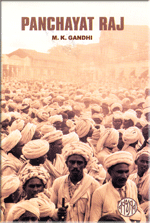
P.O. SEVAGRAM, DIST.WARDHA 442102, MS, INDIA. Phone: 91-7152-284753
FOUNDED BY MAHATMA GANDHI IN 1936
Panchayat Raj

NATURE CURE
Written by : M. K. Gandhi
Table of Contents
- Publisher's Note
- Why The Village Movement?
- Panchayats in Pre-Independence Days
- Panchayats in Independent India
- My Idea of Village Swaraj
- An Ideal Village
- Non-violent Rural Economy
- All-round Village Development
- Village Sanitation
- Rural Medical Relief
- Revival of Village Industries
- Charkha In The Villages
- Other Village Industries
- Duty of Congress Ministries
- Co-operative Cattle Farming
- Village Exhibitions
- Lok Sevak Sangh
- Samagra Gramseva
- Shanti Dals in Villages
About This Book
Written by : M. K. Gandhi
Compiled by : R. K. Prabhu
First Edition :10,000 copies, February 1959
I.S.B.N :81-7229-139-6
Printed and Published by :Jitendra T. Desai,
Navajivan Mudranalaya,
Ahemadabad-380014
India.
© Navajivan Trust, 1960
Download
Chapter-6: Non-violent Rural Economy
You cannot build non-violence on a factory civilization, but it can be built on self-contained villages. Rural economy as I have conceived it, eschews exploitation altogether, and exploitation is the essence of violence. You have, therefore, to be rural-minded before you can be non-violent, and to be rural-minded you have to have faith in the spinning wheel.
Harijan, 4-11-1939
Strictly speaking, no activity and no industry is possible without a certain
amount of violence, no matter how little. Even the very process of living is
impossible without a certain amount of violence. What we have to do is to
minimize it to the greatest extent possible. Indeed the very word
non-violence, a negative word, means that it is an effort to abandon the
violence that is inevitable in life. Therefore whoever believes in Ahimsa
will engage himself in occupations that involve the least possible
violence… This is not possible without a heart-belief in non-violence.
Suppose there is a man who does no actual violence, who labours for his
bread, but who is always consumed with envy at other people's wealth or
prosperity. He is not nonviolent. A non-violent occupation is thus that
occupation which is fundamentally free from violence and which involves no
exploitation or envy of others.
Now I have no historical proof, but I believe that there was a time in India when
village economics were organized on the basis of such non-violent
occupations, not on the basis of the rights of man but on the duties of man.
Those who engaged themselves in such occupations did earn their living, but
their labour contributed to the good of the community. A carpenter, for
instance, ministered to the needs of the village farmer. He got no cash
payment but was paid in kind by the villagers. There could be injustice even
in this system, but it would be reduced to a minimum. I speak from personal
knowledge of life in Kathiawad of over sixty years ago. There was more
lustre in people's eyes, and more life in their limbs, than you find today.
It was a life founded on unconscious Ahimsa.
Body labour was at the core of these occupations and industries, and there was no
large-scale machinery. For when a man is content to own only so much land
as he can till with his own labour, he cannot exploit others. Handicrafts
exclude exploitation and slavery. Large-scale machinery concentrates wealth
in the hands of one man who lords it over the rest who slave for him. For he
may be trying to create ideal conditions for his workmen, but it is none the
less exploitation which is a form of violence.
When I say that there was a time when society was based not on exploitation but
on justice, I mean to suggest that truth and Ahimsa were not virtues
confined to individuals but were practised by communities. To me virtue
ceases to have any value if it is cloistered or possible only for
individuals.
Harijan, 1-9-1940